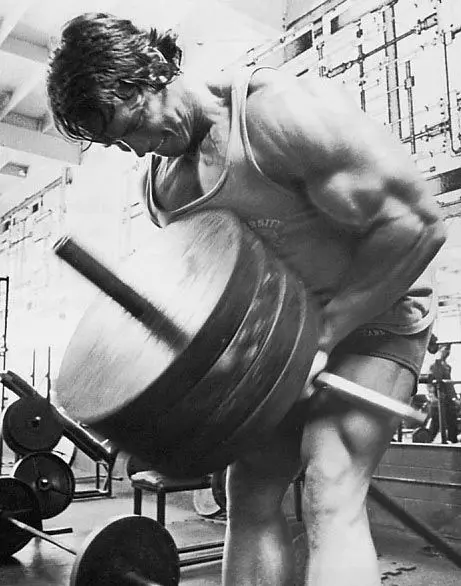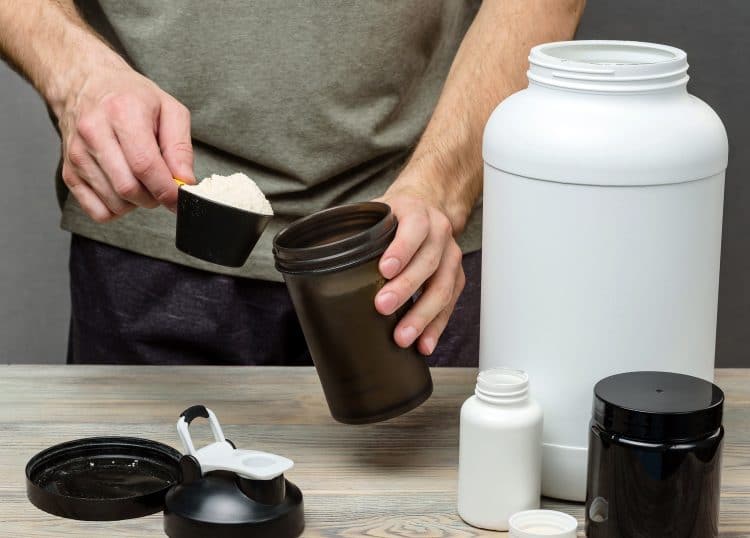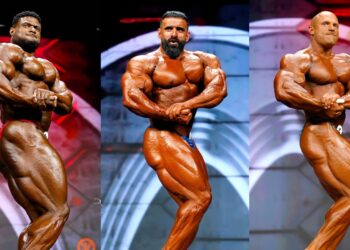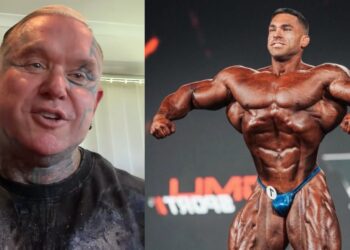Strength training is an ever-evolving endeavor.
Early humans began strength training by lifting stones. Not only did stone lifting build overall strength but it was also used to establish dominance within the community. It soon became one of the most popular competitions in the ancient times.
The physiques of the stone lifters were very different from the physiques of the bodybuilders of the modern era.
Strength training in the early years was all about lifting heavy objects off the ground and putting them back down. With time, lifters developed more convenient training equipment like kettlebells, dumbbells, and barbells and started experimenting with training volumes.
Training programs back in the day were based on instincts and gut feelings.
However, we now have scientific data that proves the best training method for biasing hypertrophy and strength gains.
Level Up Your Fitness: Join our 💪 strong community in Fitness Volt Newsletter. Get daily inspiration, expert-backed workouts, nutrition tips, the latest in strength sports, and the support you need to reach your goals. Subscribe for free!
In this article, we explore how bodybuilding training has transformed over time. Discover the techniques of the bronze, golden, and mass monster eras, as well as the science-driven approaches of today.
Ancient Ideals & Their Influence on Bodybuilding
Greek statues played a big role in inspiring humans to build chiseled physiques. Here is a brief backdrop on the periods and how the statues evolved over the years:
- Archaic Period (c. 650 – 480 BCE): Focused on idealized human form. However, the statues were more stylized and less anatomically detailed.
- Classical Period (c. 480 – 323 BCE): Sculptors mastered human anatomy, and the ripped Greek god statues were created.
- Hellenistic Period (c. 323 – 31 BCE): Sculptures became more dynamic and exaggerated, and the focus shifted to musculature and physique aesthetics.
The Role of Eugen Sandow
Eugen Sandow was a strongman turned bodybuilder who awed people in the 1890s with his incredibly chiseled physique and posing routines.
Sandow’s era is known as the bronze age of bodybuilding (1894 to 1939).
Known as the “Father of Modern Bodybuilding,” Sandow was among the first to popularize building muscle and improving physique aesthetics by using specific weights, repetitions, and exercises to achieve his ideal proportions.
In the late 1890s and 1900s, Sandow published several books in which he coined the term ‘bodybuilding.’
Sandow visited multiple museums and assessed the Greek statues using a tape measure. He used the measurements to formalize the “Grecian Ideal” to ascertain the precise dimensions for building the “perfect physique.”
Sandow organized the world’s first major bodybuilding show in 1901.
Sandow shifted the focus from lifting heavy weights to carving the perfect physique. He promoted weight training for building muscle, flexing muscles to achieve muscle mastery, and posing to show off the hard work.
The Golden Era of Bodybuilding
The popularity of bodybuilding dipped a little in the silver era (1940 to 1959). However, Joe Weider helped reignite the sport’s charm.
Joe (and his brother Ben) worked on each aspect to get people talking about the sport. They pushed TV networks to telecast bodybuilding shows, gave elite bodybuilders yearly contracts, started training equipment and nutrition companies, and published bodybuilding magazines.
The Weider brothers started the IFBB (International Fitness and Bodybuilding Federation), the world’s biggest professional bodybuilding federation, to bring a structure to the bodybuilding shows.
Weiders started the Mr. Olympia competition, the world’s premiere bodybuilding show, in 1965 and pushed for the sport’s inclusion in the Olympics.
That’s not it. Joe Weider invested resources into developing new training principles and methods, dubbed the Weider principles, to help bodybuilders get into the best shapes of their lives.
Here is the list of 25 Weider principles:
- Progressive Overload
- The Multi-Set System
- Isolation Principle
- Muscle Confusion
- The Priority Principle
- Pyramid Training
- Split Training
- The Pump Method
- Supersets
- Cycle Training
- Iso-Tension
- Peak Contraction Method
- Mind-Muscle Connection Principle
- The Cheating Method
- The Instinctive Training Principle
- Tri-sets and Giant Sets
- Rest-Pause
- Partial Reps a.k.a. Burns Method
- Descending Sets Method
- Retro-Gravity Method
- Continuous Tension Method
- Double Split Method
- Staggered Sets Method
- The Superspeed Method
- The Quality Training Method
Notably, Weider didn’t come up with all these training principles. He compiled them all in one place and helped take them to the masses.
Rise of the Bodybuilding Icons
Weider gave bodybuilders a platform they never had before.
“The Master Blaster” didn’t stop at that. He took it upon himself to travel around the world and find the best bodybuilding talent. Weider’s search for the best bodybuilders led him to Arnold Schwarzenegger.
Weider gave Arnie a contract and set him up in Venice, CA, where he trained at the mecca of bodybuilding, Gold’s Gym, Venice Beach and Muscle Beach.
Other bodybuilding legends, including Frank Zane, Lou Ferrigno, and Franco Columbu, internalized Weider’s training principles, and their rivalries (and camaraderie) helped spice up the competitive bodybuilding scene.
Some consider this era the best in bodybuilding’s history.
The golden era bodybuilders had set the standards for bodybuilding physiques — broad shoulders, a tiny waist, massive arms, a chiseled chest, and sprawling legs. The physiques were a perfect blend of size, symmetry, and razor-sharp definition.
Arnold Schwarzenegger’s Impact on the Evolution of Training Methods
Schwarzenegger popularized new training principles, which he believed helped take his physique to the next level.
Some of his most popular training principles involved:
- Visualization: Arnie is a proponent of visualizing your dream physique while you’re working out. He imagined his biceps turning into mountain peaks with each rep.
- Mind-Muscle Connection: Arnold said you must become one with the target muscle during an exercise to achieve maximum muscle stimulation. A study published in the European Journal of Applied Physiology found that focusing on specific muscles during resistance training can increase muscle activation. (1)
- Train for the Pump: Bodybuilders are pump chasers. Muscle pumps after an exercise have been shown to promote hypertrophy. The greater the muscle pump, the greater the muscle growth. (2)
- Prioritize Weaknesses: Schwarzenegger recommends tackling your weaknesses head-on. He cut all his sweatpants from the knee down while bringing up his calves to match the rest of his physique.
Schwarzenegger has shared his timeless bodybuilding advice in books like The Education of a Bodybuilder (1977) and The New Encyclopedia of Modern Bodybuilding (1988).

The Training Revolution of the Golden Era
In the bronze era, most trained to build muscle strength. Eugen Sandow, the pioneer of the bronze era, was a former strongman.
John Grimek led the charge in the silver era. He was primarily an Olympic weightlifter who began training for hypertrophy.
It wasn’t until the golden era of bodybuilding (1960–1983) that people started training primarily to build muscle mass and improve physique aesthetics by focusing on muscle size, symmetry, proportions, and definition.
Although full-body workouts from previous eras remained popular, serious bodybuilders adopted different training splits to target select muscle groups in a single session.
A chest and triceps workout and a back and biceps workout is an example of a double-muscle training split, whereas training one muscle group a day is a single-muscle training split.
This training technique helped bodybuilders focus on one muscle, leading to better mind-muscle connection and target muscle activation. Furthermore, the split training routines allowed more recovery time between workouts, significantly reducing injury risk.
Physique aesthetics were at the forefront of the golden era. Bodybuilders also spent considerable time improving their posing skills to improve their presentation.
The Growth of Gyms, Training Equipment, and Supplements
Before the golden era, athletes usually trained in their home gyms or bare-bones gyms using basic training equipment.
The 1960s witnessed the rise of the gym culture as training centers started popping up across America. Many new training machines and equipment were also introduced, which helped bodybuilders fine-tune their physiques.
The introduction of machines was a significant shift as it maintained constant tension on the target muscles, leading to maximal muscle fiber stimulation.
Bodybuilding Legends and Their Training Philosophies
Each era (and champion bodybuilder) brought their unique training philosophies to the sport. Let’s discuss the training philosophies of some of the most impactful bodybuilding legends.
Dorian Yates — Blood and Guts
The six-time Mr. Olympia champion is credited with starting the mass monster era. His immense muscle size and rock-hard conditioning helped him stand apart from his competition.
Yates formulated and aptly named his training philosophy ‘Blood and Guts.’
Here are the tenets of his training program:
All-Out Effort with Limited Volume
Yates was popular for doing one to two working sets of an exercise.
Level Up Your Fitness: Join our 💪 strong community in Fitness Volt Newsletter. Get daily inspiration, expert-backed workouts, nutrition tips, the latest in strength sports, and the support you need to reach your goals. Subscribe for free!
However, he pushed himself to muscle failure in each training set to maximize muscle stimulation. He also used drop sets and forced reps to achieve greater muscle engagement.
Yates was also known for lifting heavy and pushing the envelope in each set. He believed heavier weights led to deeper muscle contractions.
Mind-Muscle Connection
Although Yates moved heavy weights, he focused on contracting the muscles with each rep.
He trained with a spotter who helped him hold the contractions to achieve greater muscle fiber activation.
Yates popularized the Yates row, a bent-over barbell row variation performed while standing almost upright and holding the bar with an underhand grip. The Brit stated that this setup allowed him to lift heavier and contract his lats better.
Mike Mentzer — Heavy Duty
Mike Mentzer was a contemporary of Arnold Schwarzenegger. He adopted the HIT (high-intensity training) protocol developed by Arthur Jones. However, Mentzer advocated a heavier form of HIT for greater muscle stimulation, labeling his training method ‘Heavy Duty.’
Mentzer believed that most bodybuilders train for too long, which leads to overtraining and subsequent muscle plateaus.
Thanks to his high-intensity training ideology, “Mr. Heavy Duty” was out of the gym in half the time of his peers.
Mentzer’s training approach involved:
- Ultra-High Intensity: Mentzer entered each training session with the goal of doing the most in the least amount of time. He performed one to two working sets of each exercise but used forced, negative, and rest-pause reps to achieve muscle failure. Although he employed advanced training principles, Mentzer used relatively heavy weights to get the best bang for the buck.
- Pre-Exhaust Supersets: To maximize muscle fiber stimulation, Mentzer performed a set of isolation exercises before moving to the compound movement.
Ronnie Coleman — High Volume Basics
Coleman has eight Mr. Olympia titles, a record he shares with Lee Haney. “The King” carved a niche for himself through his six training videos, where he lifted super heavy weights.
Coleman believed in going hard and heavy on basic compound movements to build muscle size and strength. This is what you should know about his training regime:
- Lift Heavy: Coleman squatted and deadlifted 800 pounds for a double in his prime. He leg-pressed a monster 2,300 pounds for eight reps. Best of all, these lifts are all on video.
- Begin with Compound Lifts: Coleman always performed heavy compound movements at the beginning of the workout. He finished the training session with isolation exercises to fix strength and muscle imbalances and maximize muscle contractions to promote growth.
- Progressive Overload: Coleman tried lifting heavy with each set to build strength and muscle mass.
Core Principles of a Bodybuilding Training Program
While you might want to emulate Coleman, Mentzer, or Yates’ training program, you must remember that what works for them won’t necessarily work for you.
Your results depend on multiple factors, including your age, gender, training experience, fitness level, biomechanics, and genetics.
Bodybuilding legends devised unique training programs because they understood they needed a plan that caters to their particular needs.
Here are the fundamental principles that you must include in your training program:
- Intensity and Volume: Switch up the weights, reps, and sets, or employ advanced training principles to keep your muscles guessing. This will also ensure you’re progressively overloading your muscles.
- Personalization: Develop a training program that caters to your unique training needs, fitness level, and experience level. You must also consider your recovery capacity to minimize injury risk.
The Science of Muscle: Research Transforms Training
People are getting busier with every passing decade. They want to maximize their gains while limiting their time in the gym.
This quest has led them to explore the most scientific ways to build muscle and strength.
Most lifters no longer rely on their hunches or ‘broscience.’ They seek rigorously tested scientific methods to improve their physique.
Decoding Hypertrophy
Most published studies consider an increase in the total mass of a muscle as hypertrophy. Muscle hypertrophy occurs when muscle protein synthesis exceeds muscle protein breakdown, resulting in a positive net protein balance. (3)
Here are the mechanisms that lead to muscle growth:
- Mechanical Tension: You must subject your muscles to progressively heavier loads to build muscle tissue and strength. This is known as progressive overload.
- Metabolic Stress: Resistance training leads to a buildup of metabolites such as lactate and hydrogen ions. These conditions stimulate anabolic signaling pathways, promote the release of anabolic hormones, and trigger cellular adaptations favorable for muscle growth. In other words, muscle pumps can boost hypertrophy. (4)
- Muscle Damage: Lifting weights leads to microscopic tears in the muscle fiber. These muscles grow back bigger and stronger during the recovery phase.
Takeaway: Training creates mechanical tension in the muscles, causing metabolic stress and muscle damage. You must back your training with a balanced diet and recovery program to maximize muscle growth.
Periodization: Maximize Gains and Avoid Plateaus
Contrary to what most lifters think, going hard and heavy in each training session isn’t productive.
You must give your muscles time to rest and recuperate from your training sessions. Going full-send in each workout increases your risk of injury and can lead to muscle and strength plateaus.
Periodization involves cycling your training volume, intensity, and exercises to keep your muscles growing.
Most pro lifters include a deload week in their exercise regimen, where they significantly reduce their training volume to allow their bodies some much-needed recovery time. Advanced lifters should ideally program a deload week every four to eight weeks.
There are multiple ways to use periodization in your regimen. I highly recommend working with a personal trainer to find an approach that best fits your training experience and objectives.
Nutrition and Supplementation
As the age-old bodybuilding adage says, “You cannot out-train a bad diet.”
New research and advances in sports nutrition have helped determine the most optimal way to build muscle and strength. Here are the most important things that you should know about:

Calorie Balance
What and how much you eat will depend on your current body weight and training objective.
People trying to lose weight must be in a calorie deficit, meaning they must expend more calories than they consume. On the other hand, folks aiming to gain weight should be in a surplus, which involves eating more calories than you burn.
Macronutrients
Once you know your ideal calorie intake goal, you must break it into a suitable macronutrient split.
The three macronutrients are carbohydrates, proteins, and fats, and they play varying roles. The 40-30-30 split (carbs, proteins, and fats) is the most common, but you can change it depending on your unique needs.
Supplements
Although bodybuilding supplements have remained the same since the 2000s, their quality improves each year. The most popular bodybuilding supplements include whey protein, creatine, BCAAs, and a pre-workout powder.
Technology’s Role in Bodybuilding
New-age tech is constantly helping the sport of bodybuilding evolve. Here is how:
Advanced Training Equipment
Equipment makers like Panatta, Prime, and NordicTrack are building machines that match an individual’s body mechanics, leading to better muscle engagement. Furthermore, we are seeing a spike in home gym setups like Tonal and even VR fitness apps that are making bodybuilding more accessible to the masses.
Fitness Trackers and Apps
Most smartphones and smartwatches have built-in trackers that can provide key metrics for tracking your overall health and well-being. Calories tracking apps can help ensure you’re hitting your daily macro goals.
Role of Social Media
Platforms like YouTube and Instagram are democratizing knowledge. Now, beginner lifters can get up-to-date information from elite bodybuilders and coaches. Social media also helps foster a community that can keep you accountable.
The Future of Bodybuilding Training
After analyzing the historical trends and present development, this is the potential trajectory for the sport of bodybuilding:
Personalized Training Based on Genetics and Data
With the advancement of blood work and wearable trackers, it’s only a matter of time before we see the emergence of DNA analysis to assess an individual’s best training, diet, and recovery program.
Since genetics play a big role in physique development, personalized training based on DNA and individual health and fitness metrics will remove a lot of guesswork from the equation.
Better Supplements
Every few months, we see new supplements hit the market. While most new supplements only deliver marginal benefits over the stack that bodybuilders have used (whey protein and creatine) for a long time, one cannot rule out a breakthrough.
Return of the Old School
After the era of the 300-plus pound mega mass monsters, we are witnessing a shift toward the Classic Physique division, which aims to emulate the aesthetics of the golden era bodybuilders.
Next Read: From Sandow to Classic: The Historic Eras of Bodybuilding
Conclusion
Bodybuilding has come a long way since Sandow’s bronze era. We have seen a significant shift in training methods thanks to the introduction of hi-tech machines and scientific research findings. That said, to get the best results, you must follow a personalized training program that fits your unique needs.
Do you have a question about different training methods and how to incorporate them into your training? Drop them in the comments below, and I’ll be happy to help!
References
- Calatayud, J., Vinstrup, J., Jakobsen, M. D., Sundstrup, E., Brandt, M., Jay, K., Colado, J. C., & Andersen, L. L. (2016). Importance of mind-muscle connection during progressive resistance training. European journal of applied physiology, 116(3), 527–533.
- Hirono, T., Ikezoe, T., Taniguchi, M., Tanaka, H., Saeki, J., Yagi, M., Umehara, J., & Ichihashi, N. (2022). Relationship Between Muscle Swelling and Hypertrophy Induced by Resistance Training. Journal of strength and conditioning research, 36(2), 359–364.
- Krzysztofik M, Wilk M, Wojdała G, Gołaś A. Maximizing Muscle Hypertrophy: A Systematic Review of Advanced Resistance Training Techniques and Methods. Int J Environ Res Public Health. 2019;16(24):4897. Published 2019 Dec 4. doi:10.3390/ijerph16244897
- de Freitas MC, Gerosa-Neto J, Zanchi NE, Lira FS, Rossi FE. Role of metabolic stress for enhancing muscle adaptations: Practical applications. World J Methodol. 2017;7(2):46-54. Published 2017 Jun 26. doi:10.5662/wjm.v7.i2.46








